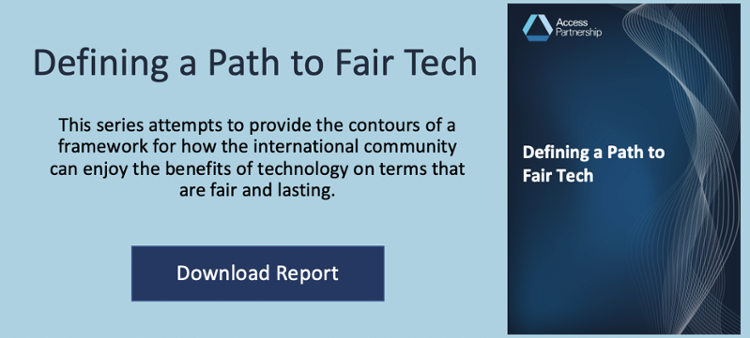Chris Adams
Director, Infrastructure
[email protected]
Infrastructure is the foundation of technology, creating and providing the platform for connectivity that enables consumers, businesses and governments to communicate, share and design. Fairness in infrastructure is often seen as beginning and ending with access to connectivity and closing the digital divide. When viewed through this lens, ‘fair’ is ensuring that anyone who wishes to can connect, that the connection is good enough for what they want to do and finally that affordability should not be a significant barrier to connecting.
Trying to achieve this is a worthy objective and we have seen many policy interventions from governments seeking to deliver it. Examples include the European Commission’s push for a gigabit society by 2025 or Australia’s National Broadband Network which target close to or complete universal access to superfast broadband. While a technology neutral approach is commonly adopted, in practice, these policies often play out as being just about connecting everyone to fibre optic cables. This outcome can be troublesome from a fairness perspective as it fails to recognise the reality of society’s real internet needs and risks excluding non fibre technlogies.
- Most individuals are browsing, shopping online, using social media and streaming content which does not require multigigabit speeds and single digit millisecond latency. New applications such as AR or VR will need this performance, although significant take up for such applications is not expected for at least a few years. The justification of ‘future proofing’ for full fibre deployment rollout doesn’t quite cut it when balanced against the sum of money involved, the multi year and shifting timeframes for delivery.
- Fairness is also compromised from a fibre only mindset as it side-lines both new and existing technologies that can deliver faster and more affordable connectivity, compared to fibre. For example, satellite can offer high speeds, significant capacity and with new low orbit constellations, low latency is possible too. Similarly, 5G promises fibre equivalent performance at materially lower costs in many deployment scenarios. Government policies must not extinguish the opportunity of other technologies to deliver connectivity and should take time to consider what is possible and what is required to ensure that fairness is prioritised.
The concept of fairness is also significant for businesses. The focus is often, and in many instances, reasonably, directed at ensuring fairness between consumers and businesses. However, it is also important between businesses. In the infrastructure space, this manifests itself in different ways. Communications infrastructure is generally a natural monopoly, the nature of the technology and how it is used produces obstacles and powerful economies of scale that make market entry challenging.
While regulators and governments are typically cognizant of and responsive to addressing competition issues surrounding the provision of infrastructure at the network operator level, in other areas, fairness remains on the periphery and lacks such scrutiny and remedy. One such area is spectrum. Regulators recognise the role spectrum can play in addressing monopolies or dominant positions in communications industries that rely on it, such as mobile networks. Consequently, regulators often use spectrum awards as a tool to address these issues. However, spectrum is such an important input for many technologies that this approach can create additional problems regarding fairness as others seek to gain access to portions of mobile spectrum bands. Fair access to spectrum is vital and technologies such as dynamic spectrum access have the capabilities to provide the solution, allowing for multiple concurrent use of spectrum in a way that maximises benefit for all. It is important that no one approach to technology is allowed to dominate large swaths of spectrum simply because it has the deepest pockets.
Another important area where fairness should be given more consideration is in relation to standards. Harmonised standards are hugely important to ensure healthy equipment ecosystems. However, they can also be a tool for locking in dominance. In the mobile equipment market, virtualization is allowing the separation of the hardware from the software; consider how a PC manufacturer does not design the software that is installed on the PC. This separation breaks monolithic networks into smaller pieces and creates the opportunity for new companies to enter the market, for either hardware or software, and offer on a much smaller scale than was previously possible in the old monolithic world. This model only works if standards are designed and in place to allow these partitions to be made.
With regards to infrastructure, ensuring fairness between and for businesses may be the most important action regulators and governments can undertake. The common link is technology, which is enabling new ways of introducing fairness into infrastructure. Leveraging this technology and seeking out areas where dominance and unhealthy concentration exist, will benefit innovation, consumers and businesses. Ultimately though it will allow governments to achieve their targets of universal access to high quality broadband, at faster and more affordable rates and having everyone connected as quickly and cheaply as possible genuinely is in the interests of consumers, governments and business alike.






